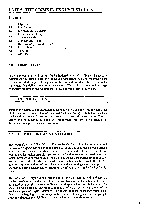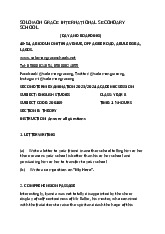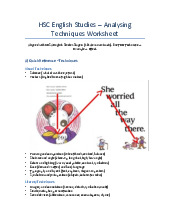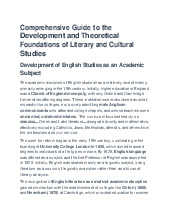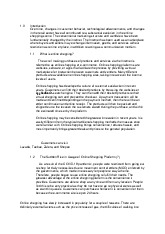







Preview text:
Department of English,
Faculty of Letters and Human Sciences, Mohamed V University, Rabat. Semester 3 Course: Grammar 3
Professor Elhassan Souali
The Adverb Phrase in English Hello, dear students. I hope you are all very well.
So far, we have covered word-level categories, the Noun Phrase, the Verb Phrase
and the Adjective Phrase in English. Today, we shall deal with the Adverb Phrase
in this language, identifying its grammatical functions and describing its
grammatical structure in terms of grammatical form, grammatical function and grammatical relation.
I. Definition and examples
The Adverb Phrase is a phrase that is headed by an adverb, like the ones put
between brackets in the following sentences (for a classification of adverbs in
English, you dealt with it in Grammar 1 and grammar 2, so in this course we will
be concerned only with how adverbs combine with other constituents to form
an Adverb Phrase, which is a major phrasal category in English: 1. a. He works [very slowly]
b. He [quite often] travels abroad.
c. He runs [faster than we thought].
d. [Very frankly], I disagree with him.
e. He made up his mind [quite independently of his parents]. f. He is walking [slowly]
g. Mary is generous; [additionally], she is very helpful.
h. Peter is [extremely] intelligent.
In (1a), the adverb phrase is "very slowly", which is headed by the adverb
"slowly". In sentence (1b), the adverb phrase is "quite often", which is headed by
the adverb "often". In (1c), the adverb phrase is "faster than we thought", which
is headed by the adverb "faster". Then, in sentence (1d), the adverb phrase is
"very frankly", which is headed by "frankly"; in (1e), the adverb phrase is "quite
independently of his parents", which is headed by the adverb "independently";
in (1f), the adverb phrase is "slowly", which is headed by the adverb "slowly"; in
(1g), the adverb phrase is "additionally", which is headed by the adverb
"additionally"; and in sentence (1h), the adverb phrase is "extremely", which is
headed by the degree adverb "extremely".
II. Grammatical functions of the Adverb Phrase in English
Before dealing with the internal grammatical structure of the adverb
phrase in English, let us first state its major grammatical functions and the
grammatical positions where this phrasal category may occur in English. We can
classify these functions into two types, namely what we may call phrase internal
functions, that is the grammatical functions of an adverb phrase inside another
phrase, and clause internal functions, that is the grammatical functions of an
adverb phrase inside a clause (or S), as shown in the following two subsections, respectively.
II.1. Phrase internal functions of the adverb phrase in English
It is well-known that phrases in English (possibly with the exception of the
verb phrase, which has a clause-internal function) may function inside another
phrase, i.e. they may have phrase internal functions. For example, a noun phrase
can function inside a verb phrase (as a direct object for example), or inside
another noun phrase (as a premodifier (e.g., [A [middle class] student]), an
adjective phrase may function inside a noun phrase, as premodifier, or inside a
verb phrase, as a subject or object complement, etc. The same thin applies to the
adverb phrase in English, which has different phrase internal functions, namely the following:
II.1.1 Functions inside the verb phrase (VP-internal functions)
An adverb phrase often functions inside a verb phrase in English, as in the following examples:
2. a. Jane [speaks [very carefully]]
b. She will [come [very soon]]
c John [[usually] stays at home] d. She [works [there]] e. John [is [here]]
In sentence (2a), the adverb phrase "very carefully" is a constituent of the
verb phrase "speaks very carefully", where it functions as an adverbial of
manner and is related to the full verb "speaks". In sentence (2b), the
adverb phrase "very soon" is a constituent of the verb phrase "come very
soon", where it functions as an adverbial of time. In sentence (2c), the
adverb phrase "usually" functions inside the verb phrase "usually stays at
home" as an adverbial of frequency and is related to the verb "stays". In
sentence (2d), the adverb phrase "there" functions inside the verb phrase
"works there" as an adverbial of place. And in sentence (2e), the adverb
phrase "here" functions inside the verb phrase "is here", namely as a
subject complement (and complement of the verb "be").
We should also point out that these adverbial functions (adverbial of
time, adverbial of frequency, adverbial of manner, adverbial of place) may
also be referred to as VP-adverbials, since they occur inside the verb
phrase and modify the full verb. They are also referred to as Adjuncts, to
distinguish them from the other two types of adverbials in English,
namely disjuncts (e.g. "very frankly", as in "[very frankly], I disagree with
you" ) and conjuncts (e.g., "additionally", "similarly", "Furthermore", etc.)
Also please note that you should not confuse the term "adverb" and
the term "adverbial". The former is a word-level category or part of
speech, like Noun, Verb, Adjective, Preposition, etc., whereas the latter is a
grammatical function, like Subject, Direct Object, Premodifier, etc. Thus, an
adverbial does not have to be an adverb phrase in English, as shown by the following examples:
3) a. I will come [in the morning] b. I will come [this Friday]
c. I I will come [whenever I want]
In sentence (3a), the adverbial (of time) is a prepositional phrase (not an
adverb phrase); in sentence (3b), the adverbial (of time) is a noun phrase (not
an adverb phrase); and in (3c), the adverbial (of time) is a clause, more
specifically a wh-clause (again not an adverb phrase). The same observation
applies to other types of adverbials (the other VP-adverbials (adjuncts), disjuncts and conjuncts.
II.1.2 Other phrase internal functions of adverb phrases in English.
The adverb phrase in English may also have other phrase internal
functions, namely inside adjective phrases (as in (3a) below), inside adverb
phrases (as in (3b)), inside prepositional phrases (as in (3c)), or inside noun phrases (as in (3d) below):
3) a. Mary is [[exceptionally] brave]
b. She walks [[extremely] fast]
c. Peter will see you [[immediately] after the meeting]
d. [The weather [here]] is very nice.
In sentence (3a), the adverb phrase "exceptionally" functions as a premodifier of
the adjective "brave" and is therefore related to it. In sentence (3b), the adverb
phrase "extremely" functions inside the adverb phrase "extremely fast", as a
premodifier of the adverb "fast". In sentence (3c), the adverb phrase
"immediately" has a grammatical function inside the prepositional phrase
"immediately after the meeting". And in sentence (3d) the adverb phrase "here"
functions as a postmodifier inside the noun phrase "the weather here", where it
is related to the noun "weather".
II.2. Clause internal functions of adverb phrases in English
The Adverb Phrase in English does not have only phrase-internal
grammatical functions but has also clause internal functions, i.e
grammatical functions at the level of the clause. These functions subsume the following:
a) Disjunct (or S-adverbial), as in the following two examples:
4) a. [ Seriously], that lady deserves our full respect.
b. [Surely], I will talk to him tomorrow.
In these two sentences, the adverb phrases "seriously" and "surely"
function as an averbial, more specifically a disjunct, which modifies the
whole clause (not just the verb phrase, as the case with adjuncts/VP-
adverbials (It should be pointed out that adverbials include adjuncts, as
shown above, disjuncts, as illustrated here and conjuncts, as shown in
(b) below). Concerning grammatical relation, we say that a disjunct is
grammatically (and semantically) related to the clause it modifies. For
example, in sentence (4a,b) above, the adverb phrase, functioning as a
disjunct, is related to the whole clause ("our lady deserves our full
respect" in the first sentence and "I will talk to him tomorrow" in the second sentence).
b) Conjunct, as in the following examples:
5) John is very honest; [Additionally], he is quite generous.
In this sentence, the adverb phrase "Additionally", which functions as a
conjunct (since it is used to conjoin two clauses), has a clause (or
sentence) internal function, not a phrasal function, since it modifies a
whole clause, namely "he is quite generous". With respect to
grammatical relation, conjuncts are related to the two constituents they
conjoin, e.g the first main clause "John is very honest" and the second
main clause "he is quite generous".
c) Subject, as in the following example:
Another quite rare clause internal function of the adverb phrase is the
function "Subject". Normally, it is the noun phrase or a clause which
often have this clause internal grammatical function, but sometimes an
adverb phrase may have this grammatical function, as in the following examples:
6) a. [Here] is better than there
b. [Now] is better than tomorrow
Before closing this subsection about the grammatical functions of
adverb phrases, we should not forget to mention that the adverbial
functions "disjunct" and "conjunct", like the adverbial function
"adjunct" presented above, do not have to be assigned only to an
Adverb phrase. In English, these functions may be assigned to other
phrasal and clausal constituents, as shown in the following examples:
7) a. [In reality], they all deserve our support.
b. [To be honest], he did not understand me properly.
c. Mary is hard working. [In addition], she is highly organized.
Notice that in sentence (7a), the disjunct is a prepositional phrase, in
sentence (7b), the disjunct is a to-infinitive clause, and in (7c), the
conjunct, is a prepositional phrase.
III. The internal structure of the English Adverb Phrase.
The internal grammatical structure of the Adverb Phrase in English
consists of the following elements: a. The Head
Like all phrases, the Adverb phrase in English must have a head of
the same type, namely an Adverb (Adv), as in the following example,
where the head of the adverb phrase "faster than I thought" is the
adverb "faster". Notice that the word "fast" is used here as an
adverb, while it can also be used as an adjective if put before a noun (e.g "A fast person"):
8) He ran [faster than I thought].
Thus, any Adverb Phrase must be headed by one and only one
adverb, and any adverb in a phrase or a sentence must have a
corresponding Adverb Phrase; in other words, the number of
Adverb Phrases we may have in a sentence should strictly
correspond to the number of Adverbs we have in it. For example, in
the following sentence, we have five adverbs, and therefore we must have five Adverb Phrases:
9) [Frankly], this [exceptionally] intelligent person [always] speaks [[too] slowly].
In this example, the first adverb phrase is "frankly" which is headed
by the adverb "frankly". This adv phrase functions as a disjunct and
is related to the whole clause "this ----slowly". The second adverb
phrase is "exceptionally", which is headed by the adverb
"exceptionally", and which functions as a premodifier of the
adjective "intelligent" (to which it is related). The third adverb
phrase is "always", whose obligatory head is the adverb "always".
This adverb phrase functions as an adjunct (or VP adverbial), related
to the full verb "speak". The fourth adverb phrase is "too slowly",
which is headed by the main adverb "slowly". This adverb phrase
functions as an adjunct (or VP adverbial), hence it is related to the
full verb "speak". And, finally, the fourth adverb phrase is "too",
which functions as the premodifier of the adverb "slowly" and which
is headed by the degree adverb "too".
b. Modifiers of Adverb
An adverb phrase, like other phrasal categories, may contain
modifiers, preceding and or following the Adverb head, as in the following examples:
10) a. Mary walks [[surprisingly] fast].
b. Mary does not walk [fast [enough]]
c. Mary understands me[[more] quickly [than her friend]].
In sentence (10a), the main adverb phrase "surprisingly fast"
contains a head, namely the adverb "fast", and one premodifier,
namely the adverb phrase "surprisingly". In sentence (10b), the
main adverb phrase "fast enough" contains a head, namely the
adverb "fast", and a postmodifier, namely the adverb phrase
"enough". And, in sentence (10c), the main adverb phrase "more
quickly than her friends" contains, in addition to the head "quickly",
two modifiers of this head (to which they are related): a premodifier,
namely the adverb phrase "more", and a postmodifier, namely the
prepositional phrase "than her friends".
It should be pointed out that while the premodifier of an
adverb in English is always a phrase, not a clause (especially a
degree adverb phrase like "very", "quite", "so", ...), the postmodifier
of an adverb in English may be either a phrase, as in (10b,c) above,
or a clause, as in the following example:
11) John runs [[so] fast [that nobody can catch him]]
The main adverb phrase in this sentence contains three constituents,
namely the head (the adverb "fast"), the premodifier (the adverb
phrase "so") and the postmodifier, which happens to be a clause
(more specifically what we shall refer to later as a that-clause),
namely "that nobody can catch him".
c. Complement of Adv
Finally, the last grammatical function that an English adverb
phrase may contain, though very rarely, is the function Complement
of adverb, as in the following example.
12) Mary reached her decision [[quite] independently [of her parents]]
Notice that the main adverb phrase in this sentence involves three
functions, namely the head (assigned to the adverb
"independently"), the premodifier (assigned to the degree adverb
phrase "quite") and the complement of the adverb "quite", namely
the prepositional phrase "of her parents".
In the next lecture, I will deal with our last phrasal category in
English, namely the Prepositional Phrase. I will also send you some
exercises concerning all phrasal categories in English. Needless to
remind you that you should be reading and summarizing the
chapters and sections of your grammar books concerning parts of
speech and all phrasal categories.
I wish you good health and good luck. Prof. Elhassan Souali
